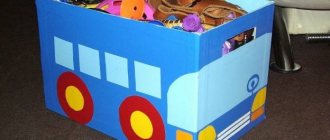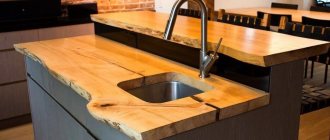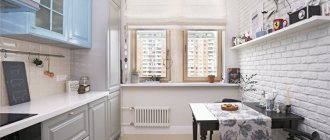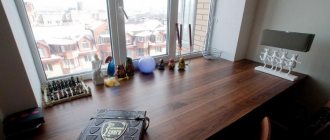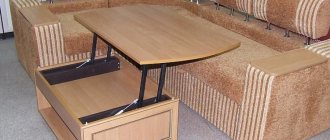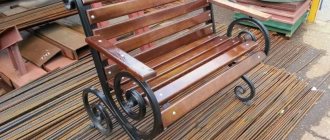An interesting fact is that most domestic furniture manufacturers do not make kitchens from plywood. This can easily be confirmed if you call companies that make custom-made furniture. At best, they will tell you something like that they don’t work with this particular material, but “any whims for your money.”
Others will start convincing you to order a kitchen set made of plastic, MDF, chipboard, laminated chipboard, solid wood, they will start to scare you with the fact that the plywood in the kitchen will swell from moisture and will lead to it.
Photo: plywood kitchen in a Parisian attic
But then I wonder why in the USA and EU countries they widely use plywood in the production of kitchen furniture (it’s worth going to the IKEA store). Probably, the main reason is that you still have to look for it in order to choose high-quality plywood, and do more work on its finishing and processing during the assembly process. Why do furniture makers need extra trouble?!
This is where a constructive idea appears: to make a kitchen out of this material yourself.
Moreover, plywood has certain advantages:
- Its environmental friendliness is better than that of chipboard, MDF, fiberboard
- It is more stable, holds threaded fasteners more firmly, and is more wear-resistant at the fastening points.
It is useful to watch the video to compare materials.
Which plywood to choose for the kitchen
Plywood is glued together sheets of veneer, of which there is always an odd number. Wear resistance and strength are achieved by placing the fibers of each sheet in different directions relative to each other. Usually birch or coniferous wood is used, while the inner part can be coniferous (GOST 3916.2-96), and the top made of birch veneer. Hardwood plywood (GOST 3916.1-96) is considered to be of higher quality and costs more.
Material classification
There are several parameters by which the material is classified:
- Brand - determines moisture resistance and scope of application. Main types of FC, FSF, FKM, FOF, FBA
- Grade - determined by the appearance of each surface. The letter E denotes the highest quality, then there is a decrease from grade I to grade IV. The grade is determined separately for the face and the back - 1/1, 2/2, ¼ and other combinations
- Surface treatment - unsanded plywood is marked with the letters NSH. If there is one sanded side - Ш1, if both sides have a polished surface - Ш2
- Formaldehyde content - the letter E with an index in the range 1-3 indicates the environmental friendliness of the material
Plywood for the kitchen must be free of formaldehyde.
To make a kitchen set from plywood with your own hands, choose sheets with average moisture resistance and no formaldehyde.
More about brands and sizes
Let us give a brief description of the main brands of plywood so that you can immediately see which of them is suitable for making furniture and which is not:
- FC - adhesive composition based on urea resins, average moisture resistance, used for interior work or furniture making
- FSF - usually used for outdoor work, moisture resistance is high. Formaldehyde resins are used as glue, so furniture is not made from FSF plywood
- FKM - synthesis of FK and FSF, veneer sheets are glued with melamine resins, suitable for any work, characterized by high moisture resistance and strength
- FBA - albumin casein glue is used to join sheets; the material is highly environmentally friendly, but has low moisture resistance
- FOF - laminated plywood. The material is covered with a film of various colors, is used in construction and furniture production, and is more expensive than other materials
It turns out that plywood for furniture is selected from materials marked FK, FKM, FOF. Standard sizes of sheets are given in table No. 1.
Table No. 1
| Brand | Width, mm | Length, mm | Thickness, mm |
| FC | 1525 | 1525 | 3 4-10 (in 2 mm increments) 9-30 (in 3 mm increments) |
| 1500 | 1500 | ||
| FKM | 1220 | 2440 | |
| 1250 | 2500 | ||
| 1525 | 3050 | ||
| FOF | 1220 | 2440 | 4, 6 9-30 (in 3 mm increments) |
| 1250 | 2500 | ||
| 1500 | 3000 |
What to make kitchen furniture from
When choosing plywood for furniture, attention is paid to the following indicators:
- Quality of gluing, wood
- General view of the sheet
- Wood species - deciduous is more resistant to temperature changes and high humidity
- Country of origin - preference is given to Russia, since Chinese materials do not have the necessary environmental friendliness, and Finnish plywood is too expensive
Taking into account the standard size of a plywood sheet, the properties of the material, quality, grade and price, the FC brand becomes the optimal choice. The selected grade is ½, sheet size 1525×1525 with a thickness of 6, 12 and 18 mm. You can make plywood products with your own hands from laminated sheets, but the cost of the material differs significantly from the FC brand.
Laminated plywood will help you build a beautiful kitchen
Features of using plywood
Plywood is made from thin veneers by gluing layers together. The number of sheets may vary. Depending on the purpose, it varies from 3 to 23 pieces. Since veneer has natural fibers, the structure of the wood is preserved, so the surface of the plywood has a specific pattern.
Each subsequent layer is applied perpendicular to the previous one, thereby increasing the strength of the sheet. Gluing is done under pressure. The finished material has a number of features. Let us highlight those that allow the use of plywood as a composite material for the manufacture of countertops.
- The nominal thickness of the plywood sheet varies from 3 to 30 mm. For the manufacture of countertops, you should choose options from 10 mm. But in its field of application, each sheet is quite durable. Strength is one of the main qualities. The slab is used as a base for a countertop, but in some cases plywood can simply be impregnated with resin, processed and the finished product is obtained.
- Plywood is resistant to loads in the direction perpendicular to the fibers, it is flexible. This quality is used when decorating, since when bending the surface does not crack or break. It is difficult to bend plywood at home, since without special equipment the process will take a long time.
- The following quality attracts all masters. Plywood is very easy to process. No special tools are needed to cut the sheet. Pressed veneer can be easily cut with a regular hacksaw, jigsaw or circular saw.
- Finally, plywood products are low cost. It is believed that this is the most accessible and inexpensive material on the construction market. To make a table, you need to look for sheets marked “Ш-2,” which means “polished on both sides.”
Useful to know > How to make imitation water from epoxy resin, basic principles
When combined with epoxy resin, plywood produces a durable, even surface. Any product will be environmentally friendly and lightweight. If you want to buy a ready-made table, you need to have a decent amount of money, since epoxy tabletops are considered the signature creation of a master. But if the table is made from plywood and epoxy resin yourself, then the overall cost estimate will please those who want to save money.
Kitchen measurements and design project
Accurate measurements plus a verified sketch of the headset will allow it to be manufactured with high quality and reliability. The main advantage of such furniture is the individuality of execution.
When making a kitchen set yourself, you should take into account ergonomic standards, the height of the housewife, the geometry of the kitchen, and the wishes of family members
Stage No. 1 - kitchen measurements
The dimensions of the room are measured taking into account protrusions, niches, and passing communications. The parameters are transferred to a sheet of graph paper in accordance with the scale. Instead of drawing by hand, using computer programs to create 3D sketches is suitable.
Stage No. 2 - sketch development
An initial version of what a plywood kitchen looks like, taking into account the arrangement of household appliances, is being worked out. Then the specific dimensions of the furniture sections - cabinets, shelves, drawers - are thought out. Taking into account the individual characteristics of the project, adhere to the developed ergonomic standards for kitchen furniture (Table No. 2). Dimensions are given in centimeters.
Table No. 2
| Floor cabinets | Wall cabinets | ||
| Height | 85 (including countertop) | Height | 70 |
| Width | 60-80 | Width | matches floor |
| Depth | 45-50 | Depth | 30 |
Additional sizes:
- For drawers, a width of 30-40 cm is suitable
- Plywood shelves are placed at a distance of 30 cm from each other
- Shelf width = cabinet width - 36 mm (frame is made of 18 mm sheet)
- The distance between the upper and lower tiers is 45-65 cm
Please remember that these are approximate dimensions and may be adjusted depending on specific circumstances.
Stage No. 3 - drawing up a design project
The sketch is complemented by the verified dimensions of cabinets, cabinets, drawers, and shelves. Additionally, the dimensions of the facades are calculated taking into account technological gaps. An individual calculation is carried out for each furniture unit. The drawing of the modules is made in two projections, indicating the dimensions, dimensions of technological holes and grooves. This will help you choose the dimensions of the plywood sheet to minimize the cost of purchasing materials.
Kitchen design made of plywood can be the most fantastic, it all depends on your imagination
Kitchen project
A kitchen made of plywood does not require complex preliminary design. But before starting work, it is necessary to carry out all the necessary calculations and measurements. After this, you need to draw up a drawing in which you should indicate the dimensions of all future furniture elements. An example of such a scheme is shown in Fig. 1.
Naturally, you can provide your own sizes of cabinets and shelves based on your personal tastes and needs. But it is worth taking into account the general rules of ergonomics, which were developed specifically for kitchen furniture. As a rule, the following dimensions are used for wall cabinets:
- The recommended height of cabinets is no more than 700 mm. Otherwise, it will be difficult for a person of average height to reach the top shelves.
- The depth of the shelves is no more than 300-400 mm.
- The width of the cabinets varies from 600 to 800 mm. In this case, it is possible to provide much narrower compartments, which are located in the corners or on the sides of the headset. The layout of each kitchen is individual, and such narrow cabinets will help fill the space of the entire wall.
Assembly diagram for a kitchen cabinet made of plywood.
The base cabinets that you plan to install in the kitchen have almost the same dimensions as the wall units. Only the height of the furniture should be greater - approximately 750-800 mm. Make sure that the height of the tabletops is approximately at the level of the hostess’s hips or slightly above this line. Furniture located below should not be too deep. But at the same time, maximum storage space should be provided.
The distance between wall and floor cabinets is usually from 450 to 650 mm.
Individual elements
After you measure the dimensions of your kitchen, calculate the number and sizes of furniture elements you need. It is worth considering the size of the built-in appliances, kitchen sink and stove. Don't forget to take into account protruding architectural features of the walls such as corners.
In addition, using a plywood set, you can quite easily hide plumbing pipes or ventilation ducts.
But it must be taken into account that access to the nodes must remain. It may be needed, for example, during repairs.
The depth and height of floor cabinets must be calculated taking into account the dimensions of the countertops. And when designing the side walls of furniture, it is worth taking into account the thickness of the doors.
After the general sketch is ready, you need to draw up a drawing of each typical furniture element. For example, for floor-standing cabinets with drawers, the diagram shown in Fig. 2.
Tools for making kitchen furniture.
Moreover, such a drawing should be drawn up in two projections: from the side and from the end. Remember that the more detailed the diagram is, the fewer mistakes you will make when making and assembling kitchen furniture.
Particular attention should be paid to corner wall cabinets. They are the most difficult to assemble yourself. It makes more sense to develop several types of project first. At the same time, you can take into account different options for opening doors: vertical, horizontal and combined. And only then choose the type that will be optimal (this depends on the overall appearance of the set and the location of individual furniture elements in it). An example of such a cabinet is shown in Fig. 3.
When drawing up a project, do not forget about the design of the doors themselves. For hanging cabinets, it is wiser to choose hollow elements made of thin plywood mounted on stiffening ribs. They are lightweight and will not create additional load on the fastenings. Floor cabinets can be made from solid and fairly thick sheets.
Preparation of materials and accessories: plywood sheets and more
Let's consider which plywood, fasteners, and accessories to choose.
The sizes of plywood sheets that need to be purchased depend on the elements being manufactured:
- Thickness 18 mm - used to assemble the frame; for cabinets, shelves are cut from plywood of the same thickness.
- Thickness 12 mm - selected for the manufacture of facades of floor cabinets.
- Plywood thickness 6 mm - suitable for wall cabinet doors that are reinforced with stiffeners.
Fasteners
The next step is to decide how the parts will be attached to each other. As experience shows, when making furniture from plywood with your own hands, it is enough to use only screws. Plywood sheets do not delaminate, do not crumble, and hardware does not come loose in the holes. Using furniture minifixes to fasten elements at home is more than problematic, since the highest precision in cutting holes in three planes is required. Having an accurate drawing, you can contact specialized workshops to make holes.
Be sure to make a drawing and then you will understand how much material and what shapes you need
So, to connect the parts you will need:
- Screws, minifixes or confirmats - European screws with a countersunk head
- Glue, silicone sealant
Fittings and finishing
This includes handles, hinges, closers, decorative plugs, if minifixes are not used. It should be remembered that kitchen furniture made of plywood is not overloaded with fancy fittings.
For painting you will need putty and paint, for pasting with film you will need putty and self-adhesive. Furniture can be covered with stain and varnish.
Tool preparation
The kit depends on how you plan to cut plywood. It is recommended to do this in a furniture workshop, since the process requires high precision and the presence of a plunge-cut saw with an attachment for cutting sheet materials. To assemble the furniture you will need:
- Cordless screwdriver or screwdrivers, drill, drill set
- Hammer, chisels, files, chisel, plane, hammer, mallet
- Plunge saw, jigsaw, hacksaw
- Tape measure, ruler, square
A standard set of tools should be in every home
Making a headset: assembling the frame and beyond
To make furniture from plywood, you will need to assemble a frame, hang doors, install shelves and drawers.
Plywood has sufficient strength, so timber is not used to assemble the frame. The parts are marked for screws or confirmations. Using a special stepped drill, holes are made with threaded and non-threaded parts, and a recess for the Euroscrew head. For a regular screw, countersinking is carried out with a drill of a larger diameter. Fastening from the front side is carried out using minifixes, then there is no need to install decorative plugs, but euroscrews are also suitable.
Before tightening the parts, the ends are coated with silicone sealant.
Headset assembly
The kitchen set made of plywood will be finally ready when the doors are hung on the frame, shelves and drawers are installed. The holes for the fittings are marked and drilled in advance, and the guides for the drawers are installed before the frame is assembled.
Assembling the headset requires care and painstaking approach
The doors are made of 6 mm thick sheets, and stiffening ribs give them stability. To cut out plywood shelves with your own hands, take material 18 mm thick. The front edges are chamfered, the sections are puttied or sanded for painting or covering with film. When processing with varnish, sanding is sufficient.
When covering your headset with self-adhesive film, give preference to expensive and high-quality material - Chinese film does not stick well and looks bad
Furniture made of laminated plywood has an ideal look - a variety of shades allows you to choose a material that suits a specific design.
DIY tabletop
A work surface made of laminate looks great. It’s easy to implement an economical option yourself by choosing a coating to match the headset or playing with contrast. The joints of the panels must be coated with sealant to avoid the harmful effects of moisture on the laminate. The front edge is closed with a decorative metal corner.
The high moisture resistance and dimensions of laminated plywood also allow it to be used as a tabletop. The film reliably protects the material from the penetration of liquids, and the edges are impregnated with a moisture-repellent composition.
Types of countertops
Before you buy a plywood and epoxy resin table or make one yourself, you need to understand the variety of choices. There is nothing worse than being disappointed in your purchase after finding a better option. Although epoxy tables come in a wide range of models, there are not so many varieties of plywood models. The fact is that, despite all the advantages of the material, natural wood or stone is traditionally valued.
Plywood is good for its ease of processing and inexpensive cost, however, the smooth surface of the veneer indicates complex wood processing, while many craftsmen focus on its original appearance (presence of bark, knots, peculiar texture).
The first type of countertop is made from plywood board. As a rule, its thickness is about 2 cm. This plate is quite strong and can withstand loads. But plywood impregnated with epoxy resin looks more preferable as a tabletop. The resin gives additional rigidity to the fibers. Ordinary plywood can be deformed, and if the load continues for a long time, the sheets may not recover their original shape. On the other hand, everyone knows how wood is affected by changes in humidity, and in a kitchen you can’t do without a protective layer for furniture. The function of such protection is precisely performed by epoxy resin.
Impregnation of plywood with epoxy resin is quite labor-intensive work; it represents the main manufacturing process. The difficulty is that impregnation takes a long time. It is necessary to apply a layer of resin and then wait until it is absorbed. The end result is a durable board coated with a thin layer of epoxy. It gives the surface a gloss and protects the wood from scratches or chips.
Useful to know > How to make a chair from epoxy resin, detailed instructions
Despite the fact that the veneer has a texture, the design can only be partially called beautiful. Therefore, before pouring the finishing layer, the surface is painted. Such countertops are not famous for their original design, but they are widely used, because in a certain interior the key elements are plain pieces of furniture.
The second type includes epoxy countertops with a plywood base. Here the plywood board is used exclusively as a load-bearing element. It is located at the base of the tabletop, and a layer of resin about 3 cm thick is poured on top. The transparent mass is rarely left in its original form. Typically, decorative elements are placed in the thickness of the resin. The exception is options using dyes.
You can use artificial flowers, natural materials, precious stones, jewelry, metal jewelry, coins and even photographs as decorative elements. Similar solutions are also found in models where the base is made of solid wood or slab. Plywood gives a smooth surface without additional processing, and we should not forget about its relatively low cost.
The third type of plywood countertops is characterized by the complexity of its structure. Usually thin sheets of veneer are used, which are held together with epoxy resin. If each subsequent sheet is slightly larger or smaller in size than the previous one, then when they are superimposed on each other, three-dimensional pictures are formed.
The size of the sheet of lower plywood may not coincide with the size of the entire tabletop, that is, such models are not considered tabletops with a base.
The most popular option is to imitate the depths of the sea. It looks like this: plywood, laid in layers, plays the role of rocks. Since they do not have smooth boundaries, the sheets of plywood must be different in size. Blue-tinted resin is poured into the remaining space.
Visually, the picture resembles a body of water, a sea depression, and if the layers of resin can be tinted zonally, then the “water” can be made darker at greater depths.
Useful to know > What products are currently made from epoxy resin
Making a dining table
To give your kitchen a finished look, try making your own rectangular shaped plywood dining table with two wide legs.
A plywood table can be made of absolutely any shape
To do this you will need the following supplies:
- Plywood for the tabletop - sheet 80×120 cm, thickness at least 18 mm - 1 pc.
- Horizontal strapping - plywood strip 15×110 cm - 1 pc.
- Tabletop and leg supports - timber with a section of 7.5×20 cm and a length of 68.7 cm - 2 pcs.
- Table leg - timber with a cross section of 7.5×20 cm, length 60.0 cm - 2 pcs.
You will need to work on every detail to make a plywood table.
Supports for table top and legs
The beam is sawn lengthwise, resulting in 4 pieces measuring 7.5x10x68.7 cm. The elements that are adjacent to the floor are shaped into legs. Marks are placed at a distance of 20 cm on each side, between which an arched line is drawn with a maximum height of 5 cm. The outer part of the support for the legs is rounded or left rectangular.
In each tabletop support, a part of a rectangular block is cut out in the center to a depth of 40 mm - the table leg should fit into the recess. The outer edges are rounded.
Table legs, horizontal strapping and table assembly
The legs are left rectangular or given a curly shape. A horizontal strap holds them together, and the part is chamfered.
After sanding the workpieces and treating them with an antiseptic solution, a plywood table is assembled:
- Connect table legs to tabletop supports and floor elements
- Tighten the structure with a horizontal strap, installing it between the legs
- Place the tabletop, tighten it with screws from below through the supports - you will need at least 4 screws on each side
All parts are fastened together with euroscrews, the caps of which are closed with plugs. The table is coated with varnish that dries for 36 hours.
WATCH THE VIDEO
Deciding on design and construction
The size of the tabletop is calculated based on the standard 70 cm per person . This is the most comfortable option.
A rectangular table is convenient if the width of the tabletop is 75 cm and the length is 90 cm. A round table is 90 cm in diameter. The standard tabletop depth is 60 cm, but this parameter can be changed if required by the room or the design of the set.
The standard table height for modern manufacturers is 75 cm. The calculation was made based on the average height of 1.65 m. The shape of the tabletop should fit well into the interior. The main requirement for it is practicality :
- Round table. For a spacious square room. Installed in the middle of the room.
- Oval table. Fits into a small kitchen. Can stand either in the middle or near the wall. Safe for children.
- Rectangular table. Functional and practical form. Suitable for narrow and long spaces.
- Square table. Ergonomic model for a small kitchen.
- Corner table. Increases the working surface.
The second stage is the choice of design:
- Standard table. Without additional functions and the ability to fold out. Traditional and most popular option.
- Sliding. Space saving. Compact when folded. The halves move apart, and an additional tabletop is placed in the middle, which is stored in the underframe.
- Folding. Table for small spaces. Consists of two separate parts, which can be assembled into one large table if necessary. This category also includes a table-book and a table-suitcase.
- Transformer. The most compact table. When folded, it is hidden in a cabinet or hanging box. Most often, the cabinet door is equipped with a mechanism that turns it into a countertop.
- Folding. Additional work space in the kitchen. One side is attached to the wall or headset, the other has a folding leg. When unfolded, one support is the wall, the other is the leg.
- With storage space. The underframe is used to place an additional shelf or drawer.
The third stage is the choice of material for the table . Let's look at them in more detail.
It can be useful:
DIY kitchen furniture
DIY kitchen chair
DIY wooden bar counter
Laminated chipboard
Chipboard is a composite material made by hot pressing wood chips mixed with a binder. The top and front are covered with high pressure laminate to form a waterproof layer.
This is the most common material , the advantages of which include low cost, wear resistance, variety of textures and colors. A chipboard tabletop is easy to install with your own hands and easy to care for.
The downside is the impossibility of seamless installation . Moisture gets into the joints, causing the chipboard to swell. The slab is losing its shape and will require repair or replacement. It is undesirable to place hot dishes on the countertop - harmful resins are used in the production of chipboard.
Acrylic or artificial stone
Composite material produced using special technology . Acrylic resin, aluminum hydroxide and pigment are thoroughly mixed in a vacuum mixer until a viscous homogeneous mass is obtained, which is poured into prepared molds.
The main advantage is the absence of microscopic pores and a seamless structure. Acrylic is hygienic, impact-resistant, easy to maintain and repair. Does not emit harmful substances. The industry produces a wide range of colors of artificial stone.
One of the disadvantages is intolerance to high temperatures. You always need coasters for hot dishes. The acrylic surface can be scratched, but chips rarely appear on such a tabletop.
Tree
Natural material, environmentally friendly and beautiful. Pros: the ability to fit wood into any interior and relatively low cost. The material is easy to process.
Surface varnishing protects against moisture. The pattern of a wooden board is always unique, and a table top made of slab (a longitudinal cut of a trunk with raw edges) makes the table unique.
Important! Don't forget about fire safety - wooden and plastic materials are highly flammable.
Among the disadvantages, special requirements for operation and maintenance are most often cited. A wooden tabletop does not tolerate hot objects; stands are always needed. It scratches easily, so cutting is done on kitchen boards. The varnish gradually wears out and needs periodic updating.
A natural stone
It is a natural material - processed rock slabs, most often granite, marble, travertine and onyx. The main advantage of stone countertops is their long service life. The high cost of such furniture is compensated by decades of use. The stone is resistant to mechanical damage, temperature and humidity. The option is always exclusive, because the stone pattern is never repeated.
The disadvantages include significant costs, complex installation and some maintenance features. Natural stone has a porous structure and can absorb liquids, which can lead to stains on the countertop. Afraid of chemical cleaning agents. Always remains cold to the touch. Expensive and elite material requires the same attitude.
Ceramic tile
The raw material for the production of ceramics is clay, which is pressed, fired and coated with glass glaze. This is an inexpensive, durable and environmentally friendly material. Among the advantages are resistance to mechanical damage, moisture resistance, and easy care . The tiles are not afraid of temperature changes and fungus.
Decoration is also a big plus in favor of ceramics . A handmade tile tabletop is a spectacular interior detail, as the industry produces a variety of colors. Mosaic made from pieces of ceramics occupies a special place in design solutions.
The downside is the fragility of the material , because the tiles are afraid of strong impacts and crack. Seams between tiles are inevitable, and special attention is paid to their tightness. The weight of the finished product is large, so the option is more suitable for a stationary table with a reinforced base.
Epoxy resin
A polymer produced by chemical synthesis . Glue from the category of compounds. Their property is that they do not shrink and do not change volume when drying. The industry produces epoxy resins complete with hardeners. To work, these components are mixed. The resin gives the product transparency, the hardener gives strength.
The undoubted advantage of a home-made epoxy kitchen countertop is its uniqueness . The resin is transparent, tinted well, and can be used to fill any decor. A properly made tabletop is very durable, waterproof and practical.
A significant disadvantage is the capriciousness of the material . When mixing components, it is important to strictly observe the proportions, temperature and time conditions.
Strained glass
In industry, this material is obtained by tempering sheet glass (heating to 680°C) and gradual uniform cooling. The technology gives the product increased strength, heat resistance and safety. Tempered glass is difficult to break, and if broken, it breaks into small fragments with blunt edges.
The advantages of a glass tabletop include its impressive appearance and numerous possibilities for glass processing. Manufacturers offer matte, glossy, transparent, colored, mirror, tinted, patterned, as well as glass with patterns and photo printing. The glass table looks light and gives the interior an airy feel. Glass is waterproof, environmentally friendly and durable with proper care.
The disadvantages include the danger of sharp corners on a square tabletop , a constant feeling of cold from the table surface and increased maintenance requirements, because even the smallest drops of water are visible on the transparent glass. The glass table makes a loud sound and adds noise, so coasters for dishes will have to be used constantly.
Interesting. Sometimes urban stainless steel or concrete decorated with beads and colored glass are used to make kitchen countertops.
Plywood
This durable material in the woodworking industry is obtained by perpendicular gluing of thin sheets of wood (veneer) in several layers. A homemade plywood table is a budget option for any kitchen. The material is flexible, but at the same time durable and easy to process. The finished table is light, mobile and durable. Plywood is not afraid of changes in temperature and humidity, and repairing such a product is simple.
The disadvantages include some restrictions on loads - regular heavy use damages the plywood countertop. The material is chosen carefully so as not to purchase a sheet unsuitable for furniture. For kitchen furniture, it is advisable to take moisture-resistant or laminated plywood of the second or third grade. We will consider the features of manufacturing and installation of such a table in more detail.
If the average height of 1.65 m is not suitable, you can calculate the comfortable table height using a simple formula. Hst ≈ 0.75 m - standard tabletop height, Рср = 1.65 m - average height, P - own height, H - ideal table height for you:
Н = Нст × Р / Рср.
For example , with a height of P = 1.8 m, the most comfortable position will be at a table with the following estimated height:
H = 0.75 × 1.8 / 1.65 ≈ 0.82 m.
Summing up
Preparing materials, furniture diagrams and drawings, and directly assembling a kitchen from plywood is a painstaking but interesting task. The headsets are durable and beautiful, the release of harmful substances is minimized. Self-manufacturing of the design allows you to take into account the nuances of a particular room and the individual characteristics of family members. If the set is a complex structure, then the table can be assembled in 1 day. Try to start with this to understand how plywood behaves and what skills will be required to make more complex structures.

